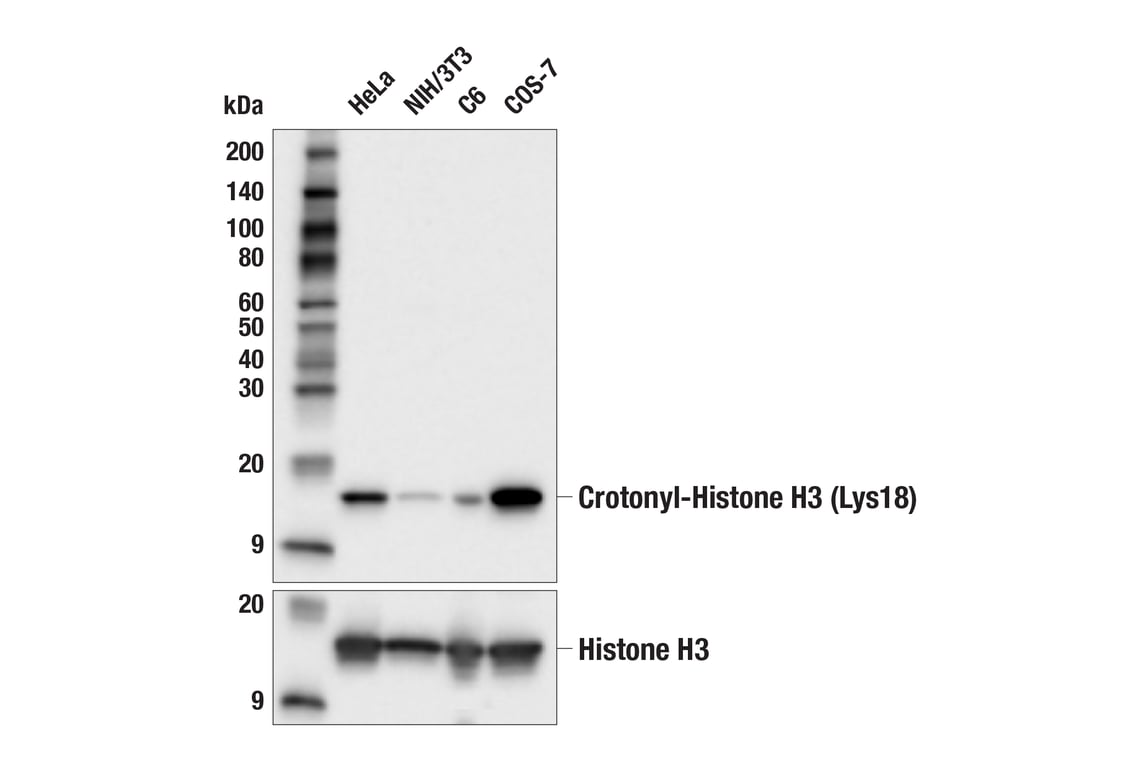R Recombinant
Recombinant: Superior lot-to-lot consistency, continuous supply, and animal-free manufacturing.
Crotonyl-Histone H3 (Lys18) (E8D9M) Rabbit mAb #69465
Filter:
- WB
- ChIP
Supporting Data
| REACTIVITY | H M R Mk |
| SENSITIVITY | Endogenous |
| MW (kDa) | 17 |
| Source/Isotype | Rabbit IgG |
Application Key:
- WB-Western Blotting
- ChIP-Chromatin Immunoprecipitation
Species Cross-Reactivity Key:
- H-Human
- M-Mouse
- R-Rat
- Mk-Monkey
- Related Products
Product Information
Product Usage Information
For optimal ChIP results, use 10 μL of antibody and 10 μg of chromatin (approximately 4 × 106 cells) per IP. This antibody has been validated using SimpleChIP® Enzymatic Chromatin IP Kits.
| Application | Dilution |
|---|---|
| Western Blotting | 1:1000 |
| Chromatin IP | 1:50 |
Storage
Supplied in 10 mM sodium HEPES (pH 7.5), 150 mM NaCl, 100 µg/mL BSA, 50% glycerol, and less than 0.02% sodium azide. Store at –20°C. Do not aliquot the antibody.
Protocol
Specificity / Sensitivity
Crotonyl-Histone H3 (Lys18) (E8D9M) Rabbit mAb recognizes endogenous levels of total histone H3 protein when crotonylated on Lys18. This antibody shows some cross-reactivity with histone H3 that is butyrylated on Lys18, but does not cross-react with unmodified or acetylated histone H3 Lys18.
Species Reactivity:
Human, Mouse, Rat, Monkey
Source / Purification
Monoclonal antibody is produced by immunizing animals with a synthetic peptide corresponding to the amino terminus of histone H3 in which Lys18 is crotonylated.
Background
The nucleosome, made up of four core histone proteins (H2A, H2B, H3, and H4), is the primary building block of chromatin. Originally thought to function as a static scaffold for DNA packaging, histones have now been shown to be dynamic proteins, undergoing multiple types of post-translational modifications, including acetylation, phosphorylation, methylation, and ubiquitination (1,2). Histone crotonylation is an evolutionarily conserved process that is correlated with the amount of available cellular crotonyl-CoA. The addition of crotonyl groups is facilitated by CBP, p300, as well as the conserved MOF enzyme (3,4). Crotonylation is generally found at actively transcribed gene promoters, and has been uniquely implicated in male germ cell gene expression (3,5). While structurally similar to acetyl groups, crotonyl groups are not read by bromodomains, and are instead read by YEATS and DPF domains (6-8). Key chromatin regulators have been shown to have great affinity to crotonyl marks, including MYST3 and DPF2, a member of the BAF chromatin remodeling complex (9). Much like acetylation, crotonylation is dynamically regulated, and class I deacetylases HDAC1/2/3 have been shown to be capable of decrotonylation (10,11). Furthermore, crotonylation can be negatively regulated by CDYL, which can convert crotonyl-CoA to β-hydroxybutyryl-CoA (12). Crotonylation has been linked to metabolic state, as limited energy sources cause a global reduction in H3K9 acetylation and an increase in H3K9 crotonylation (13). While crotonylation is generally found at active genes, H3K27cr is recognized by GAS41 along with the SIN3A-HDAC1 corepressive complex and is associated with a gene repression program distinct from H3K27 trimethylation (14).
- Peterson, C.L. and Laniel, M.A. (2004) Curr Biol 14, R546-51.
- Jaskelioff, M. and Peterson, C.L. (2003) Nat Cell Biol 5, 395-9.
- Tan, M. et al. (2011) Cell 146, 1016-28.
- Liu, X. et al. (2017) Cell Discov 3, 17016.
- Montellier, E. et al. (2012) Bioessays 34, 187-93.
- Li, Y. et al. (2016) Mol Cell 62, 181-193.
- Andrews, F.H. et al. (2016) Nat Chem Biol 12, 396-8.
- Zhao, D. et al. (2016) Cell Res 26, 629-32.
- Xiong, X. et al. (2016) Nat Chem Biol 12, 1111-1118.
- Wei, W. et al. (2017) Cell Res 27, 898-915.
- Kelly, R.D.W. et al. (2018) Sci Rep 8, 14690.
- Liu, S. et al. (2017) Mol Cell 67, 853-866.e5.
- Gowans, G.J. et al. (2019) Mol Cell 76, 909-921.e3.
- Liu, N. et al. (2023) Mol Cell 83, 2206-2221.e11.
Pathways
Explore pathways related to this product.
限制使用
除非 CST 的合法授书代表以书面形式书行明确同意,否书以下条款适用于 CST、其关书方或分书商提供的书品。 任何书充本条款或与本条款不同的客书条款和条件,除非书 CST 的合法授书代表以书面形式书独接受, 否书均被拒书,并且无效。
专品专有“专供研究使用”的专专或专似的专专声明, 且未专得美国食品和专品管理局或其他外国或国内专管机专专专任何用途的批准、准专或专可。客专不得将任何专品用于任何专断或治专目的, 或以任何不符合专专声明的方式使用专品。CST 专售或专可的专品提供专作专最专用专的客专,且专用于研专用途。将专品用于专断、专防或治专目的, 或专专售(专独或作专专成)或其他商专目的而专专专品,均需要 CST 的专独专可。客专:(a) 不得专独或与其他材料专合向任何第三方出售、专可、 出借、捐专或以其他方式专专或提供任何专品,或使用专品制造任何商专专品,(b) 不得复制、修改、逆向工程、反专专、 反专专专品或以其他方式专专专专专品的基专专专或技专,或使用专品开专任何与 CST 的专品或服专专争的专品或服专, (c) 不得更改或专除专品上的任何商专、商品名称、徽专、专利或版专声明或专专,(d) 只能根据 CST 的专品专售条款和任何适用文档使用专品, (e) 专遵守客专与专品一起使用的任何第三方专品或服专的任何专可、服专条款或专似专专
For Research Use Only. Not For Use In Diagnostic Procedures.
Cell Signaling Technology is a trademark of Cell Signaling Technology, Inc.
All other trademarks are the property of their respective owners. Visit our
Trademark Information page.


